“Is there a library or museum in Paris that will research a painting/artist for you? This is the painting Pop said he bought off a street artist in Paris in 1934 when he was at the Sorbonne. It’s oil on wood and 27 cm x 22 cm. I’d guess the artist’s name is Plilong or P.L. Long or P. Lilong.” This message went from the owner to his sister, then to his sister’s friend Mary Ann, who sent it to us. It was accompanied by an image of the signature. Could we help with a little research?
The picture itself showed a flat rural landscape under a dull blue sky in which three people (probably men) and two beasts (horses? donkeys? oxen?) are straining to move a heavy load of something brown and red along a dusty white road. The style is Post-Impressionist, hence the sketchiness of the details. At first the picture doesn’t look like much, but then one becomes aware that the artist has successfully conveyed the effort and strain of the men and the animals, the heat of the day, and the dreariness of the surroundings rather effectively for a mere “street artist.”
I squinted at the signature, and tried various combinations on Google. The one that worked best was “P. Lelong.” OK, the third letter may not look much like an “e” but the only references to “Lilong” were to traditional forms of Chinese housing. There was a “Pierre Lelong” (actually there are six) listed on French Wikipedia; the one identified as an artist is described in a terse note: “Pierre Lelong (1908-1984) est un peintre figuratif français, membre du comité du Salon Comparaisons.” (Pierre Lelong was a figurative French painter and member of the committee of the Comparisons Salon.) That was all. But it was a start.
I found some other paintings online, all signed “P. Lelong” (not Pierre or Pierre-Emile, his full name), so I think this is our man. The signatures differ slightly, but the others date from long after the 1930s, and signatures can change over a lifetime. So who was he?
A search of the library catalogue at the University of Toronto turned up a monograph written in 1957* that provided some details about his early life. Born in 1908 in Neuilly, just outside Paris, he lost his mother when he was six and was raised by his grandmother. At 16, he started art classes at the Atelier Julien on the rue du Dragon in Paris, but his studies were interrupted by his military service and then, it seems, by the need to earn a living. He went to work for an insurance company (la Mutualité Agricole), and abandoned all thought of being an artist.
But in 1933, he was doing well enough at his job to have the leisure to take up his brushes again. What our friend’s friend thought was a “street artist” in 1934 seems to have been an insurance agent, moonlighting. By 1935 he was able to rent a studio in Montmartre and to travel during his summer holidays to Spain. (If the date of 1934 is not exact, my friend’s friend’s painting might have depicted Spanish peasants – certainly the flat, hot landscape looks like Spain.)
In 1938, he married Marie-Rose Salvatori from Trinidad. (I wonder how they met.) He was doing well, exhibiting here and there, and travelling quite bit. Then came the war. He became a liaison officer with an English regiment, the Royal Dragoon Guards. So presumably he spoke English.
At Dunkirk, he was captured with other officers and interned at a camp near Dresden. Somehow, he was able to get painting materials. Strangely enough, this was the first time since his adolescence that he was able to concentrate full time on his art. What else was there to do? He painted what he saw – his fellow prisoners – waiting, eating, cooking, washing, waiting, playing cards, reading letters, waiting…
He was transferred to another camp near the Czechoslovakian border, where he worked in a garage and earned money selling paintings. He tried and failed to escape, tried again, and succeeded. It was February 1942.
For a while he settled in Clermont-Ferrand, in occupied France, and worked on his sketches from the camp. With the help of a another former prisoner, Henri Curtil, he produced a series called Une Vie de Camp, published in 1943. Then he and his wife sat out the rest of the war in Trinidad, where he went to work on his technique. He felt he’d never really mastered the art of painting. Methodically, he worked on still lifes, nudes, landscapes, and other genres until he felt satisfied with the result.
After the war, he went to the United States, where his only son, Jean-François, was born in 1946. He returned to Paris the following year, and found a studio at 10, boulevard des Batignolles. By this point, he was a full-time painter; not just a moonlighting insurance agent. He exhibited frequently, and kept busy doing illustrations for books, magazines, and newspapers. He was invited to paint a portrait of the composer Jacques Ibert, which was exhibited at a salon called “Peintres Témoins de leur Temps” (Painters Witnesses of their Times) in 1956. Lelong was interviewed on the radio, written up in the press, the picture of a successful painter. The future was bright.
But at that point, the 1957 account stops. What happened next? I found brief mentions of him in books about the “School of Paris” and so forth, but no indication of how or where he died (and only the year, not the day).
The next thing I found was a four-page exhibition brochure from 1978 on eBay. I bought it for a few Euros, because I liked the image of couples dancing on a sun-dappled square in front of a band, presumably on Bastille Day. It’s a light-filled, light-hearted, summery painting. Inside the brochure are three other images reproduced in black and white – boats, a beach, and a sunny interior with a nude. After the chilly gloom of the prisoner-of-war camp, Lelong seems to have focused on cheery scenes, full of warmth and colour. Perhaps his time in Trinidad was an influence there. He would have been 70 at the time of the exhibition.
But there the trail seemed to go cold. I tried a few genealogical websites. Nothing. I searched for any mentions of his son, Jean-Francois and his wife, Marie-Rose. Nothing. Until one day I found a mention of a limited-edition book about Lelong published in 1987, that is, a few years after his death.** Thanks to the wonders of interlibrary loan, I was able to borrow a copy from a library in Ottawa.
Along with an extended list of his many successes, including a retrospective exhibition in Nice of 150 works, I found the end of the story. Apparently, Lelong continued to paint as long as he could, working from an atelier at 74, rue des Plantes in the 14th. He vigorously defended the art of figurative paintings against the dominant abstract artists of the day. But his health started to fail in 1981, when he was 73, and he spent more and more time in hospital (it is not clear what the illness was). He died in Paris on 29 June 1984. And about six months later, his son, who was working in Morocco, died in a car accident there. I wonder what happened to his wife, Marie-Rose. Did she stay in Paris? Did she ever go back to Trinidad?
Lelong’s paintings turn up now and then in sales and on eBay, and so do copies of Une Vie de Camp. He painted mid-20th-century life in the style of the Impressionists – with cars instead of carriages, young women in short skirts instead of long gowns, motorboats instead of rowboats, electric lights instead of gaslight. Some images are reduced to geometrical shapes, but never completely abstracted. I like them. He came a long way from that initial 1930s painting, and as the research unfolded, I felt I had travelled at least part of the route with him. Our friend Mary Ann had sent us on an intriguing journey. Now to find an original we can afford…
Text by Philippa Campsie. Images by Pierre-Emile Lelong.
* Ivan Bettex, Pierre-Emile Lelong, Geneva: Les cahiers d’art-documents, no. 53, 1957.
** Bertrand Duplessis, Pierre Lelong, ou la recontre d’un homme avec l’univers, Paris: Editions SMPMD, 1987.




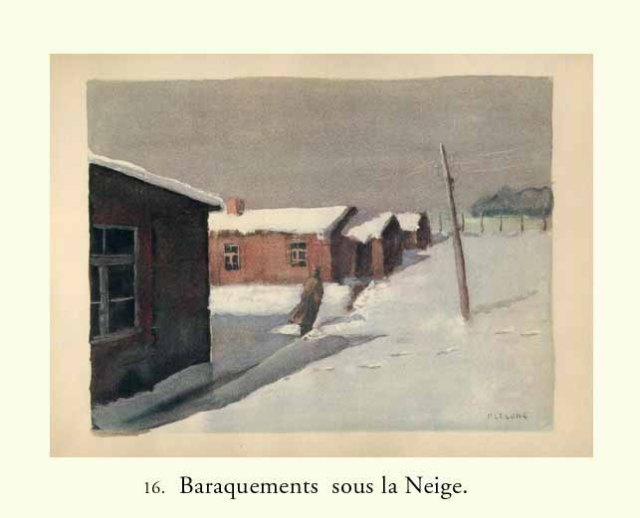









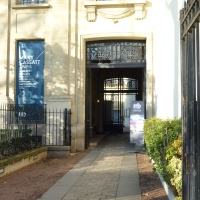

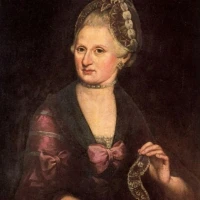
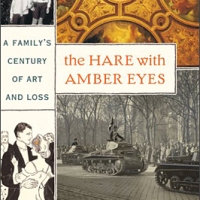
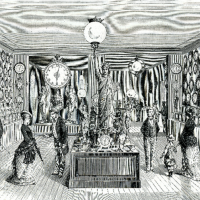
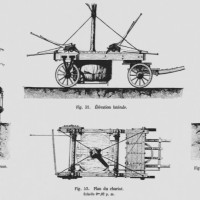
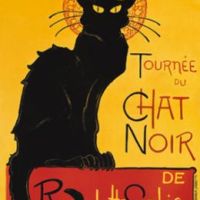









Very interesting story you have uncovered. What a chaotic life! Be careful how loudly you call for a painting of his, you may drive up the prices!
Interesting story, art, not so much. Alas.
Tastes change, I guess. He was well thought of in his day, but I suppose some people nowadays would consider his work outdated. Presumably this change in tastes has led to his having been largely forgotten. Personally, I like his work, but then, I’m rather old-fashioned in many ways!
Thank you for this wonderful article. I came across it today while searching for more information about P LeLong. I have an oil painting of his, purchased in New York City in the early 60’s. I do not want to sell it, almost everyone is enchanted by it, but I am interested in knowing if there is a market for his paintings and what the value might be.
Any information would be helpful. Again, thank you.
Hi Barbara,
I have seen Pierre Lelong’s paintings mentioned on auction websites, and one of his works sells from time to time, usually in the hundreds of Euros rather than the thousands. If you do some Google searches, you may find some examples. But I am sure you get more value from enjoying the painting! There are some of his I would love to hang on the wall.
Best,
Philippa
What a grand story to have been able to piece together. And still more questions. Will you continue to find more answers? Sad ending to lose a child; where did Marie Rose go one wonders. Thank you for your work to find out about the life of the artist.
Loved your search.. Like a treasure hunt. Very enjoyable.
Very interesting. I think his paintings are really nice.
The impressionist view of Gare St Lazare is so charming. Thank you Philippa! KB
P. Lelong was my Uncle my mentor and my God father. I own a lot of his paintings dating from 1940 to his death. Will be happy to tell you his life story.
I am Ilka Hilton Clarke and I have been looking for info on Pierre Lelong. I live in Trinidad (and Tobago) and I am the web developer of http://artsocietytt.org
I know that Pierre was a friend of artist Henri Salvatori from Trinidad who died just a few years ago in Florida. The Salvatoris here have several of his paintings.
You said ther was a book about him? I am looking for information and images for the Art Society’s website
Ilka
Hi Ilka,
After researching Pierre Lelong for the blog, I created a Wikipedia article, which lists the available books that mention him, so that is the best place to start: http://en.wikipedia.org/wiki/Pierre_Emile_Lelong (I used his middle name to distinguish him from two other people called Pierre Lelong, so you might not have found the article with a Google search).
Can you tell me what happened to Pierre’s wife Marie-Rose Salvatori? After her husband and her son died within a year of each other, I think she may have returned to her family in Trinidad, but I was never able to find out.
Thanks,
Philippa
Dear Philippa, Try jean.claude.salvatori@mail.com
This ius an email from Jean Claude Salvatori, also an artist, he is the nephew of Claude Salvatoriwho is the son of Henri ( artist Henri, friend of Pierre LeLong- he died only a few years ago in MIami). Let me know if you got through to Jean Claude. He joined the Art Society here a few years ago but I have not heard from him since
Hi Ilka, I tried that e-mail address, but the message bounced back. Might it be “gmail” rather than “mail”? Philippa
hi,
I loved the life story, I work for an antique dealer who just acquired the “pepee et los poules” and he asked me if I wanted to put it on ebay- My research on the net took me to a sale in 2010 at Christies. It looks like the prior owner sold it for $250.00 there.. Jim gets some amazing things- he also got a Luigi Rocca NYC street scene that I get lost in. Anyway I digress- thanks again for the info – many I add some of it in my ebay listing?
Jill
Hi Jill, Feel free to use the material, provided that you acknowledge where it came from. Also, as you may have seen from earlier comments, I used my research to create a Wikipedia article. Search for “Pierre Emile Lelong.” Can you post a link for those who might be interested in the sale of one of Lelong’s paintings? Thanks, Philippa
Hi Philippa,
My ebay listing is 191487840672. Thanks so much for the info, you were a great find also!
Jill
Hello, thank you so much for the research you have done on Pierre Lelong! I have just bought a lovely painting that he did presumably while in Trinidad. I will post a photo to you once I have taken one. Its a lovely Gaugin-ey painting of people sitting around a boat. I am surprised his paintings are not more collected here in France. I imagine in time he will become better known, thanks to work by people like yourself! With best wishes, John.
I knew and liked Pierre for years. We met in the South of France while I was working as a Diver in the North Sea from 1973 to 1981, He loved life, wine and painting. I presently have two of his paintings on my wall. One is of the cliffs of Dover a 5 foot by 5 foot painting the other a nude of two young girls on the beach in the South of France I carried these paintings since 1976 and have always thought of Pierre with great fondness. Tony
Dear Tony,
How lovely to hear from someone who actually knew Pierre Lelong. He sounds like a delightful person. Thank you for adding your recollections of him.
Philippa
P. Lelong was my Uncle Mentor and God father. I knew him very well and probably have some of his best works of art.
Just a note – Pierre held a Retrospective exhibit at Palais de la Mediterranee in Nice , France in August-September-October 1974.He gifted me with a poster advertising the exhibit and it hangs in my office today.
Dear Mr Joly,
How did you come to know Pierre Lelong? Can you send an image of the poster?
Philippa
It’s nice to see such interest in Pierre’s work, eh, Tony? Perhaps those researching him will follow up with Claude Salvatori to get more details, such as how Dolly (Pierre’s wife) lived out her life. Pierre showed me Paris as no other could have. I treasure his memory and was saddened by Jean Francois’ untimely death (even though he had a “crush” on my wife!).
Hello, My cousin Dr.Denise Wexler from Canada sent me this clipping, thank you my name is Annette Salvatori and I have three brothers Charles, Claude and Alan, we have an extensive collections of Uncles paintings. I can answer all your questions of my Uncle Pierre’s life and Aunt Dolly. Should you desire to talk with me my No . 772 286 8844 I now live in Fl.
Dear Annette,
Thank you so much for your comment. I would love to know more about Pierre Lelong’s life and I would love to see his work better recognized. Send a message to parisianfields@gmail.com and let me know when it would be convenient for me to call you.
Philippa